Why are buildings in Kenya collapsing?
Loading...
It's become a disturbingly familiar scene for Kenyans.
Another building collapsed Friday night in Nairobi, leaving at least 12 people dead and others injured or missing. Concerns about the safety of buildings are in the national spotlight yet again, only a year after eight buildings collapsed in Kenya.
The six-story building collapsed Friday following heavy rains, but experts say the underlying cause is poor construction, a problem reflected across the city and in many other parts of Kenya.
In Nairobi alone, only 42 percent of the cities building's are considered safe for inhabitants, according to a 2015 audit by Kenya’s National Construction Authority, the Daily Nation reported. The audit was commissioned after several buildings collapsed.
Yet the demand for housing is on the rise. As a result, more building developers are bypassing construction rules and regulations in order to meet the demand, said architecture professor Alfred Omenya in an interview with the Voice of America after two buildings collapsed last year. The problem, he says, is that developers are bribing government officials to get approval for construction projects.
“This big issue, this big elephant in the room – the corruption – that even when [inspectors] are there, they're able to allow a whole lot of substandard practices, a whole lot of illegal practices because of course, they’re actually able to extort bribes and they're not serious about doing their work,” says Prof. Omenya.
“Design work on average takes six months and accounts for 75 per cent of the professional fees, while supervision takes two years yet accounts for 25 per cent of the fee,” found a 2014 Questworks study that examined 254 samples from 24 construction sites to determine which building were at risk of collapse in case of an earthquake.
The 2014 report also found that the builders save the most money by reducing the amount of concrete and steel used in building.
While construction quality is poor across Nairobi, the most affected are low-income wage earners. According to the report, buildings in less affluent neighborhoods face a 100 percent risk of being damaged in an earthquake.
The latest collapse took place in Huruma, a poor district in Nairobi that faces housing shortages and has experienced collapses in the past. Jacob Kiruma, a resident who lived near the collapsed building, told the Associated Press that the building was constructed “shoddily.” Mr. Kiruma said that the 6-story building, with 126 rooms, was constructed in just 5 months.
“Government planning departments are not policing and enforcing supervision of buildings enough,” writes Francis Gichuhi Kamau, an architect in Nairobi.
“Due to the influx of many quacks, the highest chances are that a developer will first meet a quack who will guide him wrongly throughout the project,” he adds. “For example, the recent Huruma building that collapsed costed at least kes 20 million. A developer with the capacity to amass kes 20 million can easily afford a few hundred thousands to hire architects and engineers but unfortunately, he innocently was probably misguided by a quack for a token amount."
Apart from government steps to curb corruption in the building process, experts say residents could demand certification that shows the buildings are in compliance with the safety and other standards as stipulated by the Kenya National Construction Authority, before they sign leases.








